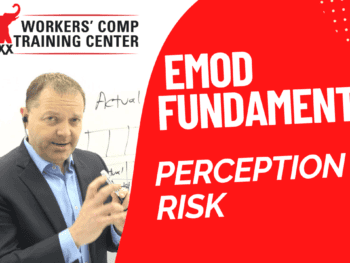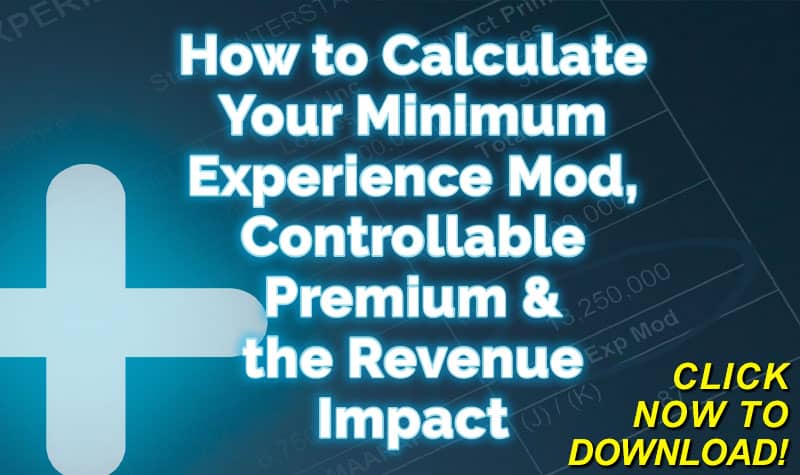Click Link to Access Free PDF Download
“How to Calculate Your Minimum Experience Mod, Controllable Premium & the Revenue Impact”
Let me talk about this in terms of a major concept, which is this actual versus expecting. So actual versus expected. Now on your worksheet, you’re gonna have something that kind of looks like this. There’s a box up front, and there’s some columns up here, and there’s some columns down here. And this is in this one, you’ve got actual and you’ve got expected. And then you’ve got a total down here. You’ve got a total down here, and let’s say this is 800,000. And this one is a 1,000,000. 800,000 a 1,000,000. Actual versus suspected, and this is a key key point, key philosophical point when when it comes to the mod.
Emod Worksheet
Because when you look at this worksheet, you’re like, there’s a ton of boxes. There’s a ton of numbers on here. What does this actually mean? In order to calculate the mod, all you’re really looking at is this. You’re looking at these two boxes, these two boxes in an NCCI worksheet. Taking this number over this number, 8 divided by 10. The answer to that, pretty straightforward. It’s point 8. Your mod is a point 8. The answer to that is pretty straightforward. Your mod is a .8, and I want to pop out also my questions. And just to remind you, if you do have questions or comments you could feel free to type those in as well, and we’ll address those as we can throughout the day to the course of the session today. 8 over 10. Point 8. That’s your mod.
Actual Losses
Major concept here, major philosophical, simple, simple, simple, simple concept to to kind of internalize. What is what did it actually happen to you? And this is the actual total over here. I think it’s in this box right here. Actual Total incurred. Where do you get this number from? Where do you get your total incurred number from? What are your clients’ total incurred number from? Your last ones. Your last ones. You could trace this right back to your last ones, your total incurred. This is a listing of how much it actually costs. It comes right off of your loss run in terms of, you should be able to match up this number for total incurred because the insurance carriers report this to NCCI, if you’re in an NCCI state or the your church rating bureau, if you’re in an independent or in a monopolistic state, they report that number. To them to the bureau. That’s how they come up with it. So your actual total incurred. What actually happened versus what was expected for you to happen? So what actually happened in terms of your total incurred losses versus what was expected for you to happen?
FREE DOWNLOAD: “How to Calculate Your Minimum Experience Mod, Controllable Premium & the Revenue Impact”
Payroll x Rate
So let me back this up again, and I wanna take you back to this payroll times rate concept. So payroll times rate. I said this was your manual premium, and this comes in down here. What was actually expected for you happen based on the class code that you’re in. So let’s say you’re a roofer, and I think these are versus an office worker. Your expected rate, let’s say, is 0.35, and this is like 0.08, something like that. If you had the same amount of payroll, let’s say you had a $100,000 in payroll, you’re gonna times that. So here payroll times rate, $100,000 times 0.35. And what is that? 35100. I think that’s right. And this is, 100 times point 8. That’s 8. That’s what, 800. Is that right? I think that’s right. 35100 versus 800.
What Actually Happened vs. What Was Expected to Happen is the Mod
What was expected for you to happen in terms of your actual losses? Versus what actually happened. So what was expected for you to happen versus what actually happened? That’s the whole thing. That’s the entire mod right there. What actually happened versus what was expected for you to happen. These rates are based on big data, big numbers, big large insurance numbers, huge big data, huge actuarial tables. These rates are based on that. That’s where it comes up. That’s where they come up with that. They come up with that in order to understand what are your expected losses? What are your expected losses? Now this number, and you could see it. I have it on there. if you go a little bit further down, whereas if it’s on there somewhere, when I talk about, definitions, it’s on page number 123. Page number 3. Of the outline there under the ELR expected loss rate. You could see that right there. So the amount of expected losses for the classification for $100 in payroll. The amount of expected losses for the classification so here’s the classification. That’s your rate. For each $100 in payroll.
And, again, don’t get lost. It’s it’s it’s gonna get easier when we talk about numbers and this times this times this times this So don’t get too lost in that and stay focused on the fundamental, which is actual versus expected, which is the whole thing of what the mod is all about. So, hopefully, that makes sense. Hopefully, you’re tracking with me in terms of this divided by this, and this is how you get this point 8 mod. Now We used an example earlier of a 1.2 mod, and I just wanna ask you to ask have you ask yourself this question? What are the actual losses if you had a 1.2 mod with the same. So let’s say this is 800 over. Let’s say your losses are a 1000. So let’s just make these numbers super easy. 800 and a 1000. What would be your actual, and this is actual, and this is expected. If you were to have a 1.2 mod, what number is this here? What number is this? And just think about that for yourself or type it into the chat. What number is this here in order to be a 1.2 mod? And I’ll just give you a second to think about it. Actual over expected is the is the amount. And I know math is hard to do in your head. It’s 1200. So 1200 over a 1000 is 1.2. 1200 over a 1000.
Compare Actual Losses to Expected Losses
Hopefully, that that makes sense. And I know these numbers can be super, super confusing, particularly when you’re doing them on the fly here. But all you’re doing there is that the actual amount of losses were higher than the expected amount of losses, so you’re doing worse than expected. So your mod’s 1.2. So, hopefully, that makes sense. Hopefully, those numbers start can can start to track with you. That’s the idea of what the entire mod is all about. It’s just that whole actual versus expected model.

Contact: mstack@reduceyourworkerscomp.com.
Workers’ Comp Roundup Blog: http://blog.reduceyourworkerscomp.com/
Injury Management Results (IMR) Software: https://imrsoftware.com/
©2024 Amaxx LLC. All rights reserved under International Copyright Law.
Do not use this information without independent verification. All state laws vary. You should consult with your insurance broker, attorney, or qualified professional.












 4 Factors to Consider When Settling Workers’ Compensation Claims
4 Factors to Consider When Settling Workers’ Compensation Claims
